Foxconn P55 Inferno Katana Preview - Quantum Force is Back
by Gary Key on August 21, 2009 10:29 AM EST- Posted in
- Gary's First Looks
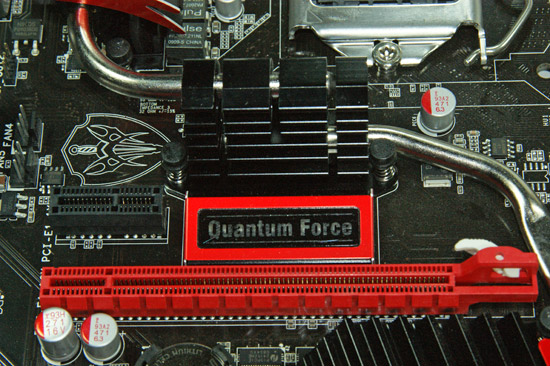
We’re Back!!! Just when we thought we had finished our P55 pictorial process, several more motherboards showed up for the launch article. We decided to continue with the pictorial process as the early September launch is quickly approaching and figured early coverage now would assist you while wading through all of the P55 choices available at launch.
Our featured product today is from Foxconn. Contrary to continued reports about Foxconn pulling out of the retail channel, they do plan to remain in this sector and have several new P55 motherboards launching next month. Foxconn will be shipping their entry-level uATX P55MX and P55A-S ATX motherboards with a price target in the low $100 range. We expect pricing to be around $115~$125.
The mid-range performance Inferno Katana GTI motherboard should launch around the $150+ range. Their top performance board and our preview subject is the Inferno Katana. This Quantum Force product should list for right under $200, maybe less. So let’s take a quick look at Foxconn’s latest design initiative.
Board Layout

We really like the looks of this board and the layout. The Inferno Katana features the VIA VT6308S chipset for IEEE 1394a support, Realtek ALC 888SD 8-channel HD audio codec with Dolby Digital Live and DTS Connect support, and a Realtek 8111DL Gigabit LAN controller. The board includes 14 USB 2.0 ports (six headers/ eight ports on the I/O panel), six SATA 3Gb/s ports with RAID 0,1,5,10 support, IDE port, and room for up to 16GB of dual-channel DDR3 memory with BIOS support up to DDR3-1800+.
Foxconn provides power-on/reset/clear CMOS switches, DMM measurement points, and a Debug LED panel for the open bench crowd. Foxconn loads up the board with six fan headers. We think this a solid feature set without going overboard on other features like JMicron RAID or an additional LAN port.
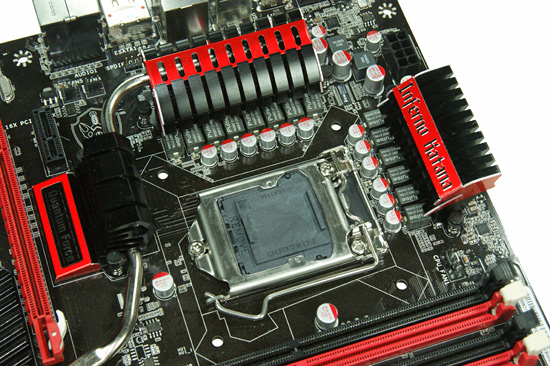
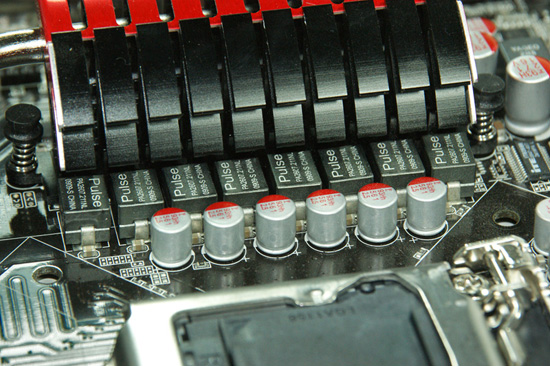
Foxconn continues with their 12-phase Hybrid PWM design along with DirectFET MOSFET technology along with 2-phase control for VTT and Memory. We have favored this design and those featuring the Volterra PWM setup for stable overclocking duties. We expect to see really good things on the overclocking side once the BIOS is fully tuned. Otherwise, the layout accommodates a wide variety of coolers easily and the back of the board is clean without obstructions for water cooling plates.
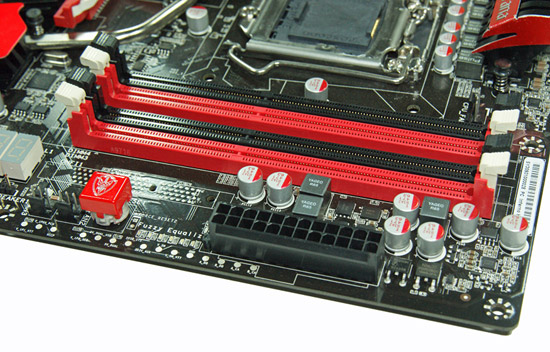
The memory slot area contains the 24-pin ATX connector, Force Reset button, and Foxconn’s “Fuzzy Equalizer” layout with LEDs to indicate PWM loading status.
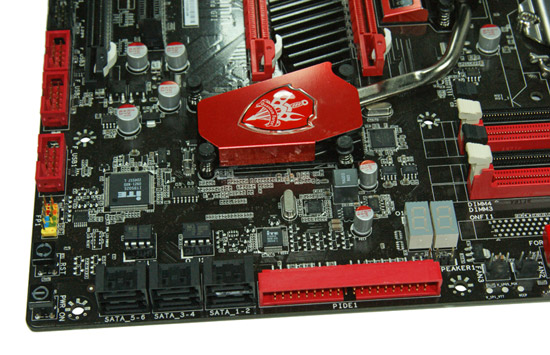
Nothing much to report here, just an interesting P55 heatsink, IDE and SATA connectors, LED Debug display, and the power on/reset switches.
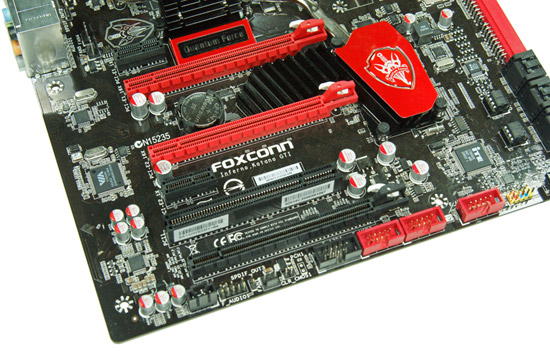
The board features two PCIe 2.0 x1 slots, one PCI slot, and three PCIe 2.0 x16 slots (x16/x4 or x8/x8/x4). The third x16 PCIe slot (black one, x4 electrical) is provided by the P55 chipset and is not designed for optimal graphics performance although the board will support 3-way CrossFireX. The layout of the PCI/PCIe slots is very good and allows for a single PCIe x1, PCIe x4, and PCI slot when running SLI or CrossFireX configurations with dual slot cards. Due to the close proximity of the red x16 slots, custom cooling solutions might not work with two cards.
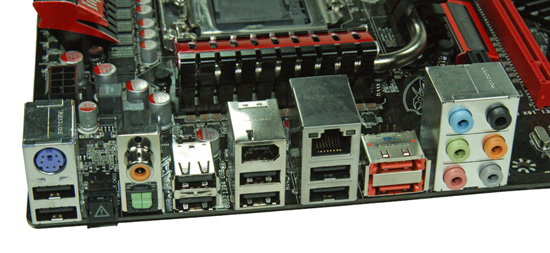
The rear panel features a PS/2 keyboard port, optical/coaxial S/PDIF out ports, eight USB 2.0 ports, Gigabit LAN port, IEEE 1394a port, two eSATA ports, audio panel, and the clear CMOS switch.
















25 Comments
View All Comments
MadMan007 - Friday, August 21, 2009 - link
Please be sure to explain how the PCIe lanes get assigned in different situations in your review. Not just 2 graphics cards but if you use a 4x or 1x PCIe peripheral in the second graphics card-designated slot. This is more important for mATX mobos.I find it confusing that there are 16 lanes for graphics cards slots PLUS 4 lanes for another slot when there are a total of 16+4 lanes total in the CPU+P55 because that implies that none of the peripherals are PCIe. I would be sorely disappointed if the GigE in particular is attached through PCI.
snakeoil - Friday, August 21, 2009 - link
why they put a fake nortbridge heatsink, the crippled lynnfield has no nortbridge, do they think that users are stupid?, i think the idea is to charge 350 dollars for a fake heathsink and remember that this doesn't have pci express 2x16 which sucks.MadMan007 - Friday, August 21, 2009 - link
Dammit snakeoil I'm dissapointed. You forgot...WHAT'S WRONG WITH INTEL?
MadMan007 - Friday, August 21, 2009 - link
Gosh I'm DISAPPOINTED there's no edit, I usually like to fix my typos. -.-AssBall - Friday, August 21, 2009 - link
In your case, I guess they made the right assumption about users.JumpingJack - Friday, August 21, 2009 - link
Are you some kind of troll?snakeoil - Friday, August 21, 2009 - link
no, im just asking a question.JumpingJack - Friday, August 21, 2009 - link
It sure sounds like it. Intel launched Core i7 into high end desktops first as well as servers, Lynnfield as it should be apparent, is simply a waterfall down to the midrange segment. It is not a crippled i7 as you put it, it is a new design for a targeted segment. Intel put in a DMI interface and eliminated a separate IO chip, going from a 3 chip to a 2 chip design, which brings down costs substantially. They also removed one channel of in the memory controller, and are not using a QPI link, thus making it a smaller die. All of which brings down costs for the overall platform.This is not the first time companies launch into the high end first, to follow up later with mid-range and lower end products, the only real question is how will it perform against the competitive landscape -- i.e. Core 2 Quad and Phenom II -- in the same marketsegment. All the leaked info so far shows an i5 750 slightly slower than the slowest i7 (the 920), which would put it somewhere ahead of both the Q9650 and Phenom II 965.
Considering that it is pricing in at just over 200 dollars, and MB will be significantly cheaper to make and market, there should be some more downward price pressure on the C2Q and PII lines.
Now, in terms of the heatsink -- the designs so far all show heat sinks on logic chips for all the P55 boards, because, yes there is still one chipset on the board, it is essentially the southbridge with some PCIe lanes built in. So, naturally, it should be passively cooled.
brybir - Friday, August 21, 2009 - link
I think we all know what to expect from Snake. General Intel bashing. Him and that other guy do it quite a bit in every post they make. Most of us have learned to ignore it.99% of us are aware that mid level parts are functional varients of the more expensive CPU's.
In any event we shall see benchmarks and retail pricing soon enough and then we can decide for ourselves whether we buy this "crippled product" or not.
JumpingJack - Friday, August 21, 2009 - link
:) Yeah, I was being a bit facetious -- he post this same message at other sites where I read the comment section as well, hence the 'troll' label.